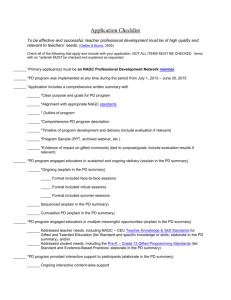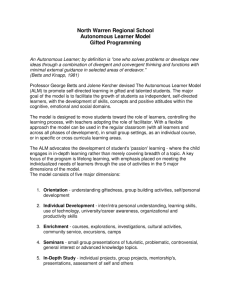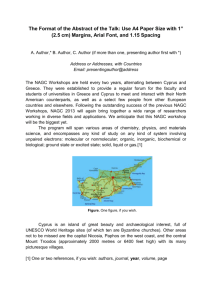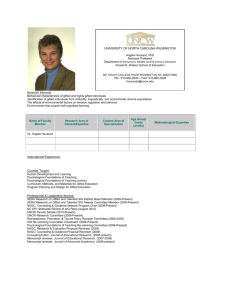Developing Autonomous Learners
advertisement
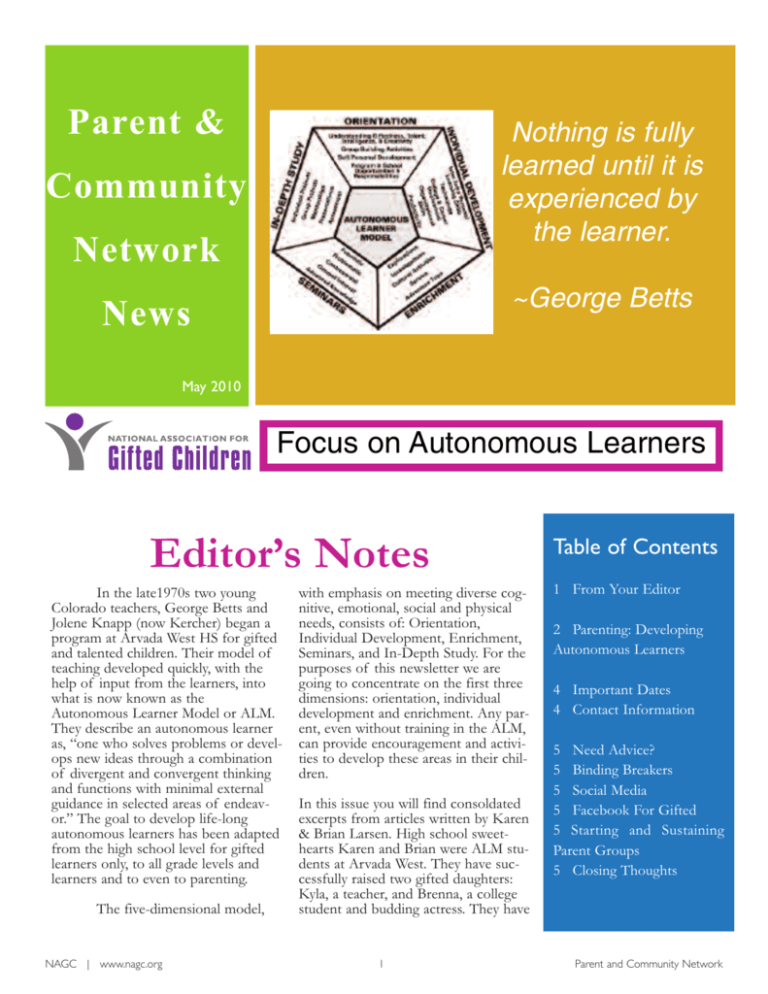
Parent & Community Nothing is fully learned until it is experienced by the learner. News ~George Betts Network May 2010 Focus on Autonomous Learners Editor’s Notes In the late1970s two young Colorado teachers, George Betts and Jolene Knapp (now Kercher) began a program at Arvada West HS for gifted and talented children. Their model of teaching developed quickly, with the help of input from the learners, into what is now known as the Autonomous Learner Model or ALM. They describe an autonomous learner as, “one who solves problems or develops new ideas through a combination of divergent and convergent thinking and functions with minimal external guidance in selected areas of endeavor.” The goal to develop life-long autonomous learners has been adapted from the high school level for gifted learners only, to all grade levels and learners and to even to parenting. The five-dimensional model, NAGC | www.nagc.org with emphasis on meeting diverse cognitive, emotional, social and physical needs, consists of: Orientation, Individual Development, Enrichment, Seminars, and In-Depth Study. For the purposes of this newsletter we are going to concentrate on the first three dimensions: orientation, individual development and enrichment. Any parent, even without training in the ALM, can provide encouragement and activities to develop these areas in their children. In this issue you will find consoldated excerpts from articles written by Karen & Brian Larsen. High school sweethearts Karen and Brian were ALM students at Arvada West. They have successfully raised two gifted daughters: Kyla, a teacher, and Brenna, a college student and budding actress. They have 1 Table of Contents 1 From Your Editor 2 Parenting: Developing Autonomous Learners 4 Important Dates 4 Contact Information 5 Need Advice? 5 Binding Breakers 5 Social Media 5 Facebook For Gifted 5 Starting and Sustaining Parent Groups 5 Closing Thoughts Parent and Community Network utilized the ALM in their parenting that led to their success as parents. If you want more information about the Autonomous Learner Model you can find it at www.alpspublishing.com. And for an even more enriching experience, I highly recommend you and your family attend the ALM conference held annually in June in Estes Park, Colorado. It is a great combination of an enriching conference and family vacation. Families are welcome and participate in many activities. I call it “gifted camp” and have attended over 10 conferences, each time renewing friendships while learning an amazing amount of information in a very casual and beautiful setting. Dr. Betts also runs the Summer Enrichment Program (SEP) for gifted children at the University of Northern Colorado, Greeley. ing of “ We are all in this together”. There are many free and inexpensive activities, such as simply playing a board game together, that can serve as group building activities. We sat down as a family and brainstormed a list of activities we would like to do together. We cut the list apart, put the items in a can, and drew out one item each week. These were relatively simple, inexpensive activities (no trips to Tahiti here) that we could do in a short period of time. Sample selections: Go to the airport (it’s fun to visit all the shops and see the artwork there), go for a bike ride, have dinner in front of the fireplace, have a read-in. The point is we have fun things to do together rather than face the age old question “what do you want to do?” “I dunno.” or by default spending the evening in front of the television. The message we tried to give our children was that we were making a conscious decision to spend quality time together. We choose them over the television. We are all on a journey trying to define who we are and how we fit in the world. The TV was off at our dinner table and we ate dinner together almost every night. This time was valuable to us and we did not sign up for activities that would interfere. It was at the dinner table that we reconnected and discussed the day’s events and how they affected each one of us. Asking open-ended questions such as, “Tell me about a new friend you have made at school, or what do you think is the most difficult part of being in middle school?” lends to more in-depth answers instead of “How was school today? (fine)”. We made a point to identify positive personal attributes of our children. “Kyla, I really admire your choice of friends. It seems you really know how to pick people who value the same things you do.” or “Brenna, you have the best sense of humor!” We asked them to tell us what they thought they were particularly good at and what they thought their sister was good at doing. We all needed to work together as a team. Both parents work full time in this home, so everyone needs to pitch in if we are going to have time together. The girls had daily and weekly responsibilities such as feeding the rabbits, folding laundry, making their beds, dusting, making their own lunches and helping with meal preparations. June Cleaver does not live with us. Note from Karen: I could not be as good of a mother if I had to do all the cooking, cleaning, picking up after everyone and work full time. Brian scrubbed toilets and floors, the kids did their part, and we all had time together because of it. Individual Development Practically since our children were born, we have been talking about college and career planning with them. Parenting: Developing Autonomous Learners by: Karen and Brian Larsen While at Arvada West High School in the late 70’s, we were fortunate to be students in the Autonomous Learner Program with Dr. George Betts and Jolene Kercher. (Yes, we were high school sweethearts!) As students, we found this to be a great model for learning. As the parents of two now-grown daughters, we feel that the Autonomous Learner Model (ALM) is not only a great model to use in the classroom, but it also works well as a parenting tool. We used the ALM in our everyday parenting. While we are far from perfect parents, this model helped us to develop the whole child. The five-dimensional model gave us opportunities to guide our daughters and helped enable them to become autonomous learners and choose career paths that suit them well. Here are some activities that we did as a family to support the first three dimensions of the ALM. Orientation We encouraged our children to try out a wide variety of activities. How do you know what you are good at if you have never tried it? If you try something and like it, great! We’ll support you in that. If you try it and don’t like it, no problem, try something new. A caveat here: if you sign up for a set of lessons, you are committed to that set of lessons, but don’t have to take another set of lessons. Hint: rent equipment! We also limited the number of activities so that we still had time to be together as a family. Group Building activities help foster the feelNAGC | www.nagc.org 2 Parent and Community Network “What do you want to be when you grow up?” is a question children hear all the time. Our oldest child told people when she was three years old that she wanted to be a buggy pusher at King Soopers, a cooker at McDonald’s and a doctor. (Can you tell how we spent our days?!). Our youngest insisted that she was going to be a scientist writer - what ever that meant. Karen wanted to be a ice cream truck driver - ice cream and music in one job!. Brian always wanted to be a police officer. We understand that in order to make appropriate decisions that a variety of factors needed to be considered. We visited college campuses when we traveled. We talked about positive aspects of college, talked about financial planning and what expenses we would cover and what we would not be covering. We talked about the cost of college so they understood it is a big investment. Kids today will have at least 3 different careers and more than 10 different jobs. The average job duration now is three years. Gone are the days of the company man retiring with the 35 year gold watch, so they must learn transferrable skills. Enrichment As parents, we felt it was important to model volunteerism. Brian coached soccer and served on boards for various non-profit organizations. He also helped with Habitat for Humanity, although he decided not to give up his day job for electrical work! Karen also served on non-profit boards, both local and national, as well as on many, many school committees and helped out in the classrooms. We performed these functions because we felt a need to give back to the community. A side benefit was that our children saw how volunteerism is an important part of our lives. The person who volunteers NAGC | www.nagc.org gets rewards back: a sense of accomplishment, being involved in life, making a difference in the community, the chance to take on other roles outside of your vocation. You never know, a volunteer activity may just lead to a new career. As a family, we looked for opportunities to make volunteerism part of our every day lives. For example, every night when we went for a family walk, we always took a grocery bag with us and tried to fill it up with trash. Sometimes we had to point out the trash to the kids, but they were pretty good about picking it up on their own understanding the consequences of littering! We encouraged the children to take on their own volunteer projects. At school, both girls volunteered to be conflict managers and served on the student council. At home, Kyla always had a deep concern for homeless animals. She collected cans and saved her allowance to buy pet food to donate to the Humane Society. For her 13th birthday, she asked her guests to bring a can of dog or cat food to the party instead of presents. We took a whole trunk full of food to the shelter when others heard about what she was doing. These days, every article you read in magazines tells you to “Just Say NO” to taking on volunteer projects. It is common for people to scale back the amount of time spent on helping others in order to have more time for the family. But by getting the whole family involved in a volunteer project, it is possible to combine quality family time with a volunteer activity. Volunteering opens up your vision of the world. “The Adventure Trip” is perhaps our family’s favorite component of the ALM. Travel is a shared family passion at the Larsen household! We have two large maps hanging in a room in our home. 3 One is a map of the United States and the other is a map of the world. Each family member has a different colored set of dots to place on the maps to mark the places visited. We began traveling with the children when they were infants. Our feeling is the earlier they are exposed to new people and new places the better they would be at adapting to new situations. It’s difficult to learn proper restaurant behavior if you never go to a restaurant. Adventure trips can be very short in duration ie. one hour , or can span a normal two week family vacation. The difference between a regular vacation and an adventure trip is the amount of input the children have in each. In a typical family vacation, mom and dad select where they are going, make all the arrangements, do all the packing and then tell the kids where they are going. We have all seen the results of these types of trips with parents yelling at the kids, “Now quit fighting and HAVE FUN!!!” An Adventure Trip experience is where the children have as much say as possible in the trip. Once we told the girls the time frame of our trip and how much we had to spend. They researched and chose the destinations and were responsible for the route planning. They met with the representative from AAA Travel. The man from the agency was wonderful. He helped them design and map out a “trip ticket” which showed the entire route. He discussed the merits of quickest route vs scenic routes and suggested several side trips we hadn’t thought of. Their main goal was to go through as many states and provinces as possible to put more dots on our maps! Our car trip took us through Nebraska, Iowa, Minnesota, Wisconsin, Ontario, Manitoba, Saskatchewan, North Dakota, South Dakota, Wyoming, and back Parent and Community Network home to Colorado. The kids had made reservations at all the motels Dates to Remember: we would stay in along the way and helped plan and outline what we could do in each location. A 3700 Webinars on mile car trip could have been one long whine fest, but we all had a Wednesdays great time and saw parts of the world we might not have ever seen. (WOW) The plains of Canada were breathtaking with fields of bright yellow May 19 cannola on one side of the road and Summer Strategies: Summer fields of purple lavender that went on as far as the eye could see on the Reading Choices other. The benefits of letting the That Make Sense children have input in planning an by Susannah Richards & Adventure trip include: * No “how long before we get Laura Beltchenko there” comments. * You stay within budget when the May 26 FREE kids are keeping track of the money. Making Your Case: 10 Ways to Several times they chose to go to a local supermarket to get food items Boost Your Gifted Program rather than going out to eat. * We have the best mileage records Sally Krisel that we have ever kept with the kids June 9 traking what we spent on gas and figuring out what our mileage was at Setting Your Course for Fall each stop. * We saw and did things we probaSuccess: Using the PCM bly never would have thought of Professional Development doing. Since the kids were more willing to gather information they Materials were informed consumers. * While we retained the right to Cindy Strickland veto any suggestions, we never had June 16 to use it. Connecting for High Potential: * Quarreling was never an issue as they were very invested in making Parents and Teachers Partnering this a successful trip. Our behavioral expectations for Successful Outcomes for an Adventure trip include: Keri Guilbault June 23 Summer Strategies:What Web Resources Work for High Ability-Learners Brian Housand Sign up at www.nagc.org NAGC | www.nagc.org *We are creating memories on this trip. Do you want our memories to be of sibling bickering, whining, and complaining, or do you want our memories to be of a great time together as a family *Treat people with respect and kindness - we are ambassadors of our country/ city / family and treat your travel companions the same way. 4 *Stay with us or if we do separate, be where you are supposed to be. We don’t want to spend our vacation in a panicked state. We taught the children what to do if we get separated. Each child carries with her at all times a typed itinerary with phone numbers including where we are staying, flight numbers, emergency contact information and photocopies of their passports, if needed, along with a small amount of cash. *Part of experiencing a new place is trying new foods and being respectful of the people who made those foods. Our expectation is that you politely try the new food and then if you don’t like it, don’t make a big deal about it, just quietly don’t eat it.” Our children learned many skills: map reading , budgeting, research skills, and more importantly, how to appreciate other people, cultures, and places. Travel memories are treasured by the parents and children and are an important part of what makes us a family. Parent & Community Network Chair: Pauline Bowie paulinebowie@mac.com Chair Elect: Christy McGee cmcgee@bellermine.edu Newsletter Editor: Kathy Jones gimajones@gmail.com Parent and Community Network Need Advice? AskA Zoe student of Tamara Fisher has created an advice website to address the issues children and adolescents have. Who is Zoe? According to her website: I'm a teenager who's been through some of the tough social situations in life. Now, I'm using my experience to help other kids. If your child has questions they want answered from sibling rivalry to friendships to pet questions and the like, just Ask Zoe. www.askzoe.tripod.com Binding Breakers Do your children want ideas on what book to read next? Check out the student-created webskite called Binding Breakers. Their mission....In a society that finds more value in how students take tests, rather than helping them discover the love of learning: we want to promote the reading of books. http://ops.esu8.org/~jenniferbauer/B indingBreakers/Home.html Social Media Revolution Has social media and social networks become intrinsic to our lives? Watch this YouTube video and see what you think. http://www.youtube.com/watch?v=lF Z0z5Fm-Ng Facebook For Gifted Here are just some of the pages and groups on Facebook where you may network with others interested in giftedness and gifted education. Once you have an account, just run a search for them. NAGC; Parenting Gifted Children; SENG; GE 2.0; PHP; Parenting Gifted or Advanced Children; Chamber of Gifted; Center for Gifted Studies; Gifted Kids Network; Gifted Homeschooler’s Forum; Our Gifted Online Conferences; Hoagies. Note that just because the word gifted is used in a title of a page, the content may not be related to gifted education. The sites I have listed are legitimate but are not all inclusive. NAGC | www.nagc.org There are many sites that state affilitates have created and more sites being created nearly daily. Starting and Sustaining Parent Groups Dear Parent & Community Network Members, NAGC, the Parent Advisory Committee and the leaders of our network are working on an exciting addition to NAGC’s list of advisory books, articles, etc. This 32 page ebooklet entitled “How to Start and Sustain a Successful Parent Group” will be ready for dissemination at our 2010 national convention at Atlanta. HOW YOU CAN HELP Below you will see the proposed content of the booklet listed in 8 categories. I know you have stories, examples, vignettes, testimonials, etc. that would give the reader real-life examples of how to accomplish each category. Under each heading I have suggested ways our members might contribute, but please, you are not limited to what I suggest. Remember, this is a condensed booklet so we will not be able to use everyone’s suggestions. CONTENT: This useful guide for parents and caregivers of gifted and talented learners will be jam packed with vignettes and testimonials, practical case studies, and checklists addressing the following topics and others to be determined: 1) Why start a parent group and what makes these groups successful? Reasons you started your group, what one or two things did you do that made it work? 2) Setting up and running an effective parent meeting, do's and don'ts. Stories of effective meetings and funny stories of the not so successful ones and why. 3) Working with like minded organizations within your community. Who really helped your group get started, what organizations did you look to for models or help? 4) Getting organized: your group as a legal entity--what should you consider? What hints do you have for beginners? What “issues” did you run into that 5 were unexpected? 5) Leadership roles and responsibilities within the group. What roles were the most important to your group? Who needs to do what and why? 6) Resources at your fingertips--what's available to help you? What were your best resources? Were there any hidden jewels that helped you to survive? 7) Building a strong community outreach program 8) Suggested meeting topics for consideration What were your best topics? Funny stories about topics that “flopped”. 9) Stories from the trenches: What's the best aspect of your parent group and why? And always those heartwarming, funny, and even disastrous stories that you lived to tell about. TIMEFRAME FOR COMPLETION: We are working on a tight timeline for the book to be ready by convention. Please send your suggestions, stories, resources, etc. to me, Christy McGee, at mcgee@bellarmine.edu no later than June 1, 2010. I look forward to hearing about your support groups. Thanks, Christy McGee, Parent & Community, Chair-elect Closing Thoughts “To our children: At last we are begin- ning to understand you. We realize your beauty, your ability, your potential. A lifetime of excitement, joy, involvement, creativity and passion awaits you. But first we must nurture you. We must give you the opportunity to accept and value your strengths and your differences; to accept and value the strengths and differences of others; the opportunity to actively pursue your passions, your areas of adventure and your dreams.; to help make our world a better place in which to live, where, as you choose, you may become the explorers, the inventors, the artists, the poets, the leaders of tomorrow. But most importantly, we must help you to become your true selves; to withstand the pressures from outside and to listen closely to your hearts so that you may develop your potential and become what you truly can be, what you truly are.” ~ George Betts Parent and Community Network The NAGC Mile Marker Series Your Road Map for Supporting Gifted Children Think of it as your GPS for the world of gifted and talented education. More than a map or tour book, the NAGC Mile Marker Series is an interactive guide to the best resources for supporting gifted children. With this tool, you’ll be able to easily target the information you need, right when you need it. You’re the driver. Take the route that makes sense for you. Whether you have questions about giftedness in general, or specific concerns about programs and services, or want ideas to build advocacy efforts, this easy to use CD-ROM provides answers and resources all in one place. Begin your journey...order a copy today! Order today at the NAGC Web site www.nagc.org or call 202/785-4268
